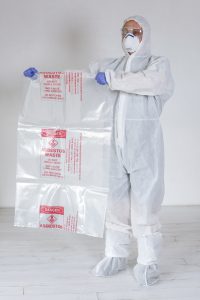While in all states and territories (except the ACT) homeowners are permitted to remove a maximum of 10 square metres of bonded asbestos; we recommend that you play it safe and use a licenced asbestos removalist. And if you are planning on removing asbestos yourself, you MUST take the appropriate safety precautions.
However, if you need to remove more than 10 square metres, you MUST either hire a qualified asbestos removalist or, in some states you are required to obtain a bonded asbestos removal licence which requires you to attend an appropriate training course run by TAFE or a registered training organisation.
IMPORTANT: Any loose or friable asbestos MUST be removed by a qualified asbestos removalist and cannot be removed by the homeowner.
For more information please refer to Safe Work Australia’s Model Code of Practice: How to safely remove asbestos July 2020.
Is it Safe to Remove Asbestos Yourself?
If you must remove it yourself, you MUST take precautions! Removing asbestos can be a dangerous and complicated process. We recommend using licenced professional removalists who will also dispose of it in accordance with government regulations.
Quick Links
- For instructions on how to remove asbestos safely download our Fact Sheet 1 or 2.
- Safe Work Australia’s Model Code of Practice: How to safely remove asbestos July 2020.
- The Department of Health have produced Asbestos — A guide for householders and the general public
- To locate your closest asbestos disposal facility visit the Asbestos Safety & Eradication Agency’s disposal database
- The relevant authority in your state and territory can provide you with information about the hazards and risks that home renovators may face from a range of chemicals and materials, including asbestos.
- Australian Capital Territory – Asbestos Taskforce ACT
- New South Wales – Asbestos NSW
- Northern Territory – Asbestos NT
- Queensland – Asbestos Queensland
- South Australia – Asbestos South Australia
- Tasmania – Asbestos Tasmania
- Victoria – Asbestos Victoria
- Western Australia
The important point is this: if you need to work with materials that may contain asbestos, you must work so there is minimal release of fibres, dust or small particles from the asbestos materials.
It is recommended that if you are considering removing or working with asbestos yourself, you undertake a training course to ensure you have the training to do it safely.
IMPORTANT: If the asbestos is in powder form or can be crumbled, pulverised or reduced to powder by hand pressure when dry, it must be removed by an asbestos removal contractor with a friable asbestos licence.
DIY Guide To Removing Asbestos
If you are thinking about removing even a small amount of asbestos yourself, to protect your health and the health of those around you including children, at the very minimum you should meticulously follow ALL of the steps listed on this website and in Safe Work Australia’s Model Code of Practice: How to safely remove asbestos July 2020.
For instructions on how to remove asbestos safely download our Fact Sheet 1 or 2.
Working with Asbestos
-
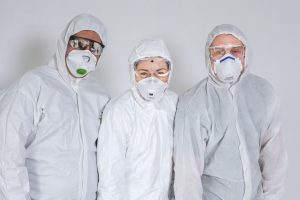
Work Safely
- Cover up and wear PPE (Personal Protection Equipment).
You should wear the appropriate Australian Standards-approved PPE (Personal Protection Equipment) including respirator or dust mask recommended for the job (see manufacturers’ information when selecting and using this equipment).
Make sure your mask has two straps to hold it firmly in place. Don’t use masks that only have one.
Also wear a hat, gloves, disposable coveralls with a hood, and safety glasses or goggles to protect your eyes. - Do not eat, drink or smoke in the work area as you may inhale or eat dust.
Wash your hands and face with soap and water before meal breaks and when finished work for the day.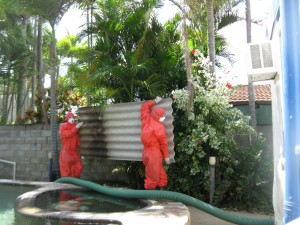
- Do not use power tools
Asbestos fibres can be released if power tools are used for anything other than the removal of screws. - Do not waterblast or scrub with a stiff broom or brush.
It is illegal to waterblast asbestos cement sheets. If the material has been accidentally waterblasted or has suddenly deteriorated in some way, you should call a licenced asbestos removal contractor. - Wet gently with water.
When removing asbestos cement sheets, use a pump spray to lightly dampen the sheets and keep the dust down. Remember: it is illegal to waterblast asbestos cement materials. - Avoid drilling and cutting into asbestos products.
Do not drill holes through eaves, flues or vents, as these may also be asbestos products. Never cut into an asbestos cement sheet. Instead remove the entire sheet and replace it with a non-asbestos product. - Don’t drop fibro sheets.
Remove asbestos sheets carefully. Lower them to the ground, don’t drop them, to minimise breakage.
- Cover up and wear PPE (Personal Protection Equipment).
- Let People Know
Plan to have family members and pets away from the work area until after the clean-up. Talk to your neighbours and anybody else who may be affected by your removal and disposal of asbestos cement materials. - Prepare The Area
- Outside
- Lay plastic sheeting under the work area to prevent any dust contaminating the ground. Use 200um thick plastic sheeting or bags; these must not be made from recycled materials or re-used for any other purpose;
- Move children’s play equipment away from the work area;
- Close windows and doors and seal vents to stop dust getting into the house; ask neighbours to do the same;
- Seal off other places where dust can get in, such as under doors.
- Inside
- Close doors and use tape and plastic sheets to seal the work area off from areas inside the house to prevent contamination of other areas.
- Use 200um thick plastic sheeting or bags; these must not be made from recycled materials or re-used for any other purpose;
- Tape plastic over the floor;
- Cover vents, air conditioning and central heating ducts;
- Remove soft furnishings, rugs and curtains from the work area, or seal them in plastic if they can’t be moved;
- Lay plastic sheeting under the work area to prevent any dust contaminating the flooring. Use 200um thick plastic sheeting or bags; these must not be made from recycled materials or re-used for any other purpose;
- Move children’s play equipment away from the work area;
- Seal off other places where dust can get in, such as under doors.
- Outside
Cleaning Up
- Stack & Wrap
Stack asbestos cement material carefully on plastic sheets, double wrap and tape, while still in the work area. Use 200um thick plastic sheeting or bags; these must not be made from recycled materials or re-used for any other purpose. Clearly label as asbestos waste. - No Skidding
When stacking sheets, do not skid one sheet over another, as this will release fibres. - Remove immediately.
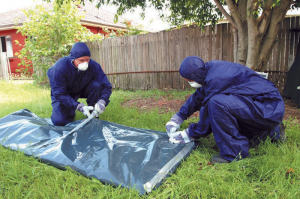
Do not leave sheets lying about where they may be further broken or crushed by people or traffic. Remove all asbestos waste as soon as you can. - Clean up everything.
Make sure that no dust leaves the work area on shoes, clothing, tools etc. Put used disposable overalls and masks in bags for removal with other asbestos waste. - Vacuum cleaners
Do not use house-hold vacuum cleaners. Use only vacuum cleaners that comply with AS/NZ 60035.2.60 that are fitted with appropriate attachments to reduce the release of asbestos fibres and dust. - Avoid dry sweeping which stirs up dust.
Dampen dust with a “mist” of water from a spray pump pack.
Safe Transport & Disposal
Dispose of all asbestos waste promptly. For safety reasons always: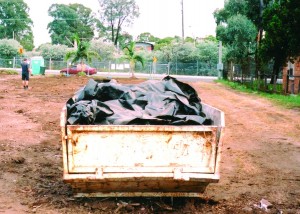
- Dampen all asbestos waste and double wrap in plastic and tape. Use 200um thick plastic sheeting or bags; these must not be made from recycled materials or re-used for any other purpose. Clearly label as asbestos waste.
- Transport all asbestos waste in a covered, leak-proof vehicle.
- Dispose of asbestos waste at a landfill site that may lawfully receive the waste. It is illegal to re-use, recycle or illegally dump asbestos products, or to put asbestos waste in domestic rubbish bins.
- For more information about legally transporting and disposing of asbestos waste, contact the relevant authority in your state or territory.
- Australian Capital Territory – Asbestos Taskforce ACT
- New South Wales – Asbestos NSW
- Northern Territory – Asbestos NT
- Queensland – Asbestos Queensland
- South Australia – Asbestos South Australia
- Tasmania – Asbestos Tasmania
- Victoria – Asbestos Victoria
- Western Australia
Other Things To Keep Your Eye On
- Hail damage to your roof or any asbestos cement product can be as bad as waterblasting. Call a licenced asbestos removal contractor immediately if there has been heavy hail.
- Watch for weathering. Surface weathering can lead to the release of asbestos fibres from roofs. Weathered asbestos products can release fibres when disturbed, such as when asbestos roof or gutters are removed. All asbestos roofs should be sealed before they are removed to reduce the risk of asbestos fibres being disturbed.
- Fire damage. Fire damaged property containing asbestos product could result in loose asbestos fibres. A licenced asbestos removal contractor must be used for cleaning up.
- Keep guttering (and downpipes) in good repair. As asbestos fibres collect in gutters after heavy rain, guttering and downpipes should be in good repair on buildings with asbestos roofing. Downpipes should not run into garden beds. Wet, clean and seal roof gutters before removing them.
- What about insulation? Insulation materials in house roof spaces are usually fibreglass, rockwool, paper or foam. Very few houses in NSW have loose asbestos insulation in the roof space. If you suspect that your property may have asbestos insulation in the roof space, contact NSW Fair Trading or the Asbestos Taskforce in the ACT.
- When to coat asbestos products. Many fibro walls are painted and there is no risk associated with painting bonded asbestos. Just make sure that you do not sand the surface before painting.
Remember
Coating is not considered necessary on health grounds. Surface coatings, however, may provide an extra level of protection against the possibility of asbestos fibres being disturbed and becoming airborne and can extend the life of asbestos products. Special sealants only should be used on asbestos material, as ordinary paints do not bond well to the surface of weathered asbestos cement products. Seek professional advice and use a professional painter, where possible. Do not sand surfaces before painting. Damaged roofs must be sealed before removal.
Check If Your Asbestos Roofing Needs To Be Replaced
Roofing that has weathered to the point where it is structurally unsound and no longer waterproof should be replaced. If you decide to coat your roof, have a professional do it.
See Asbestos Disposal and Asbestos Legalities for detailed information about the safe disposal of asbestos.
Share this information on:


